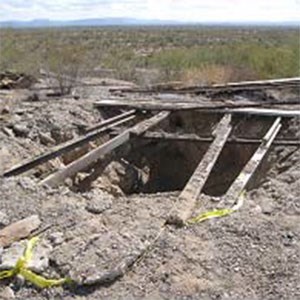
NPS photo
Forty-three parks in the Intermountain Region have AMLs consisting of underground mines where copper, lead, silver, zinc, and gold were mined;surface mines where cinder, stone, sand and gravel were excavated;and energy minerals sites where uranium, coal, oil and gas were extracted. In addition, many caves were mined for bat guano.
Many AML sites have been reclaimed and hazards mitigated. The 1990s was a particularly active period when four parkwide AML environmental assessments were prepared for Buffalo (1993), Big Bend (1994), Guadalupe Mountains (1996), and Fort Bowie (1997). The State of Texas AML Division used $250,000 in SMCRA funds to construct bat-gates, cupolas and grates at 18 shafts and adits at Big Bend's Mariscal Mine, and $65,000 to construct 10 closures at Guadalupe's Calumet Copper Mine, however, Texas was the only State in the IMR with SMCRA funds available to mitigate hardrock AML hazards. In 1995, National Park Foundation recognized the NPS-State partnership for the Big Bend project with a Partnership Leadership Award. Also during the 1990s hardrock features were closed in Canyonlands, Capitol Reef, Colorado Monument, Dinosaur, Fort Laramie, and Glen Canyon using NPS funds via cooperative agreements with the Colorado and Utah AML agencies. In 2009, Bat Conservation International provided $40,000 to construct a bat-gate at an adit in Grand Canyon. In 2009, with the American Recovery and Reinvestment Act, the largest influx of AML mitigation funds was made available with $5,006,000 to fence and sign 144 hardrock features in Saguaro and construct long-term or permanent closures at 85 hardrock features in Black Canyon of the Gunnison, Chiricahua, Coronado, Fort Bowie, Glacier, Glen Canyon, Grand Canyon, Organ Pipe Cactus, and Saguaro;and reclaim 13 gravel pits in Great Sand Dunes.
Regional Priorities for Site Restoration
Preservation
- Wildlife Issues—Many hardrock AML features provide bat habitat. AML features in two parks are used as maternity and post-maternity roosts by the federally-endangered lesser long-nosed bat (Leptonycteris curasoae). Pre- and post-closure bat surveys, including application of the WNS survey protocols and collecting sediment and water samples for analysis, are needed where bat-accessible closures are constructed.
- Cultural Resources—Mining history is an important emphasis area for IMR. Big Bend's Mariscal Mine is one of the largest Historic Mining Districts in IMR. During 2010-2012, IMR completed parkwide determinations of eligibility (DOE) for hardrock AMLs in Coronado, Glacier, Grand Canyon, Organ Pipe Cactus, and Saguaro;and DOEs were completed for specific hardrock AML sites in Black Canyon of the Gunnison, Chiricahua, Canyonlands, Capitol Reef, Curecanti, Glen Canyon, Grand Teton, Great Sand Dunes, Petrified Forest, Wupatki, and Zion, and for oil and gas sites in Big Thicket. Additional DOEs are needed to evaluate the historic significance of AMLs that have not yet been assessed.
Reclamation vs Restoration
- IMR has a large number of AML structures, most of which are historically significant. Structures proposed to be stabilized will require an historic structure stabilization plan.
- Where wetlands have been impacted, AML mitigation will include restoration of wetland functions and values.
- Consultation with the Arizona SHPO resulted in determining that standard mitigation techniques, including the construction of bat-gates, cupolas, and grates are acceptable;however, where features are to be permanently closed by backfilling, fill will be placed to within 3 feet of surface at which point fill will be placed to surface on only one side of the hole to build a wildlife ramp. Where hazard mitigation at a specific feature requires backfill to surface, standard cultural resource photographic recordation will be done.
Last updated: February 8, 2016
